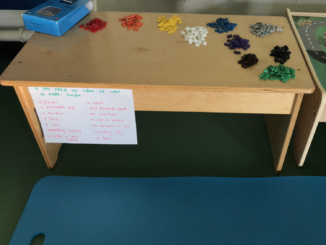At my lecture last Friday, during the Q&A session, somebody asked me if I had any ideas for connecting meaningfully and playfully in therapy with a child whose special interest was vacuums, and who spent most of the session searching the clinic in hopes of finding a vacuum.
I gave a few ideas right off the top of my head, and I know vacuums are not a completely unheard-of special interest, so I thought I’d share them for anyone else who it helps. And then over the weekend I thought of an even better idea, so I’m sharing that too in hopes maybe the person who asked will come to this page and see it!
So here were my vacuum-play related ideas:
1. If he’s already searching around the clinic in hopes of finding a vacuum, why not create a scavenger hunt where the end result is you find a vacuum? (Or multiple vacuums, could be a scavenger hunt to all cleaning closets!) I’m using the word “scavenger hunt” very generally here because this could look a ton of different ways. Maybe you actually write out clues and follow the clues to find vacuums. Maybe you put tape paths down on the floor and balance along them to lead to each closet. Maybe you start the scavenger hunt WITH a vacuum and push it around and the written clues lead you to little piles of sand or dirt you can vacuum up!
2. What if you cleaned out a vacuum ahead of time so the dust bin of it was clean, and then vacuumed up things like pom poms or foam stickers or another lightweight fine motor manipulative with the tube part of the vacuum, and then you could empty them back out and do something else with them or repeat the process.
3. Why not paint or draw directly on a vacuum? Equally easy to apply to many many other special interests! Washable tempera paint is already so easy to get off of things, or you can mix it 50% dish soap 50% washable paint for an even more wipe-off-able medium. Then you’re drawing and writing on a 3D and vertical surface, what great fine motor work!
4. Get a vacuum manual and see if there’s anything interesting in it to highlight or circle or draw or color in or copy down to another paper.
5. Use screwdrivers or other tools to take apart a vacuum or try to put it back together. You don’t have to use the clinic’s vacuum, but you could check thrift shops or “buy nothing” groups for a vacuum that it’s OK to trash if the experiment goes poorly.
And the bonus idea I thought of later:
6. You could absolutely lay out pre-writing shapes (circle, triangle, square) or pre-writing lines (wavy line, looping line) or alphabet letters or numbers or whatever with sand or dirt or, like mentioned before, pom-poms or some other lightweight manipulative. You could lay it out on the ground or outside or whatever. And then use a handheld vacuum or the tube extension of a regular vacuum to suck it all up while practicing moving your whole arm in the shape of those pre writing lines or letters! Which honestly sounds so fun I kind of wanna try it even though I don’t have any kids who are passionate about vacuums right now.



